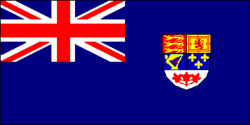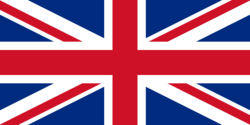Flag of Canada
|
|
The National Flag of Canada, popularly known as the Maple Leaf Flag (French: l'Unifolié "the one-leaved"), is a base red flag with a white square in its centre, featuring a red stylized 11-pointed maple leaf.
For much of its post-Confederation history, Canada had used the British Union Flag as its official national flag, with various versions of the Canadian Red Ensign as popularly recognized specifically Canadian variants.
| Contents |
Adoption

Ca!1964p.gif

Although the idea of a new design for the national flag had been discussed for decades in the 20th century, it was in the 1960s that the debate intensified and became a subject of considerable controversy culminating in the Great Flag Debate of 1964. The principal political proponent of the change was Prime Minister Lester B. Pearson, while the main opponent was the leader of the opposition and former prime minister, John Diefenbaker, who made it his personal crusade not only for sentimental reasons but also for political advantage. Eventually, a multi-party parliamentary committee was established to select a new design. Through a period of study with some political manoeuvring the committee came up with the current design, which was created by George Stanley, inspired by the flag of The Royal Military College of Canada, in Kingston, Ontario. The design was adopted unanimously by the Committee on October 29, 1964. The new flag was adopted by the House of Commons on December 15, 1964 (the Senate added its approval two days later).
Queen Elizabeth II proclaimed the new flag on January 28, 1965. [1] (http://www.canadianheritage.gc.ca/special/flag-drapeau/proclamation_e.pdf). It was inaugurated on February 15, 1965, at an official ceremony held on Parliament Hill in Ottawa in the presence of the Governor General, His Excellency General the Right Honourable Georges P. Vanier, the prime minister, the members of the Cabinet, and Canadian parliamentarians. Since 1996, February 15 has been commemorated as National Flag of Canada Day [2] (http://www.canadianheritage.gc.ca/special/flag-drapeau/declaration_e.pdf).
Despite the preceding acrimony, the new flag was quickly embraced by the Canadian public, and internationally the flag quickly became a welcome and easily recognizable marker of Canada worldwide.
Symbolism
The white centre is a device unique to Canada, blazoned a Canadian pale, being a pale 1/2 the width of the field rather than 1/3 (in heraldry, a pale is a vertical stripe). The flag is blazoned Gules, on a Canadian pale argent a maple leaf of the first.
In 1921, King George V proclaimed the official colours of Canada as red, from the Saint George's Cross, and white, from the French royal emblem since King Charles VII.
As early as 1700, the maple leaf began to serve as a symbol celebrating Canada's nature and environment. The maple leaf on the flag is highly stylized with 11 points and does not wholly correspond to the wild variety of maple leaf (with 23 points). The number of points on the leaf has no significance; they do not, for instance, represent the ten provinces plus the federal government. In fact, some of the very first Canadian flags made had maple leaves of 15 points: the lower single points were tripled like the top three.
By a figure-ground reversal of the white square and the maple leaf, the two upper corners of the square can be seen as silhouettes of two angry faces arguing. This has often been considered evocative of the nature of Canadian federalism, but was wholly unintentional.
Captain_Canuck1.jpg
In Canadian Culture, various patriotic comic book Canadian superheroes use the Maple Leaf Flag as the basis for their costumes, much like how Captain America's costume is based on the Stars and Stripes flag. Hence, these characters' costumes are typically red and white with a red maple leaf as their symbol. Canadian superheroes who use this visual motif include:
- Captain Canuck
- Guardian and his successor, the Vindicator
- Northguard
Flags of Canadian provinces and territories
Alberta - British Columbia - Manitoba - New Brunswick - Newfoundland and Labrador - Northwest Territories - Nova Scotia - Nunavut - Ontario - Prince Edward Island - Quebec - Saskatchewan - Yukon
See also
External links
- National Flag of Canada (Department of Canadian Heritage) (http://www.canadianheritage.gc.ca/progs/cpsc-ccsp/sc-cs/df1_e.cfm)
- Flag Etiquette in Canada (http://www.canadianheritage.gc.ca/progs/cpsc-ccsp/etiquette/index_e.cfm)
- Template:FOTW
- The flag of Canada (http://portal.wikinerds.org/canada-flag)
| National flags |
| List of national flags | List of national coats of arms |
fr:Drapeau du Canada it:Bandiera canadese he:דגל קנדה hu:Kanada zászlaja ja:カナダの国旗 pl:Flaga Kanady pt:Bandeira do Canadá sv:Kanadas flagga zh:加拿大國旗 nl:Vlag van Canada


